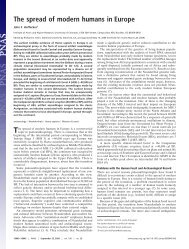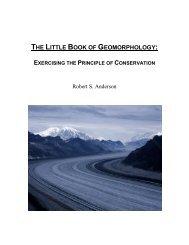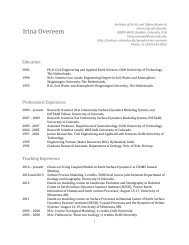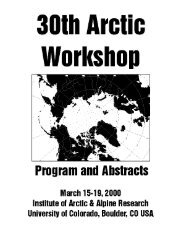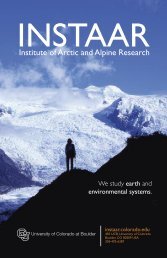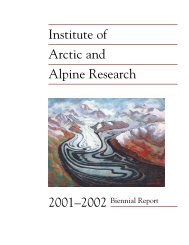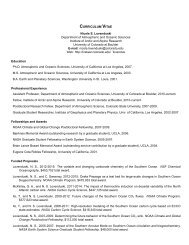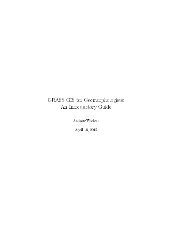Glacier Mass Balance and Regime: Data of Measurements and ...
Glacier Mass Balance and Regime: Data of Measurements and ...
Glacier Mass Balance and Regime: Data of Measurements and ...
You also want an ePaper? Increase the reach of your titles
YUMPU automatically turns print PDFs into web optimized ePapers that Google loves.
to estimate the effect <strong>of</strong> calving on sea-level rise. The calving <strong>of</strong> floating glaciers, <strong>of</strong> course, has noeffect on sea level, but most small glaciers have grounded termini.Glazovskiy (1995) has estimated the rate <strong>of</strong> calving for glaciers in the Russian Arctic. Brown etal (1982) compiled calving rates for the Alaskan coast. In 1999-2000 mass balance <strong>and</strong> ice motionmeasurements were carried out on Mendenhall <strong>Glacier</strong> (Juneau Ice Field, Alaska). Comparisons <strong>of</strong>several topographic maps (first is in 1948) <strong>and</strong> surface pr<strong>of</strong>iles determined in 1995, 1999 <strong>and</strong> 2000 byairborne GPS-guided, laser-ranging elevation pr<strong>of</strong>iling system (described in Echelmeyer et al., 1996)have helped to calculate iceberg calving into the lake, which was 6.2% <strong>of</strong> surface melting value longtermperiod (1948-2000), <strong>and</strong> 5.7% in 1999-2000 (Motyka et al., 2001).Unpublished estimates <strong>of</strong> totalcalving for Patagonia <strong>and</strong> Tierra del Fuego have been communicated by P. Holmlund, <strong>and</strong> for Svalbardby J.-O. Hagen. Meier (unpublished) has made crude estimates <strong>of</strong> calving discharge for the CanadianArctic <strong>and</strong> for small glaciers around Greenl<strong>and</strong> <strong>and</strong> Antarctica by estimating the width <strong>of</strong> calving fronts<strong>and</strong> individual calving rates based on analogous climatic regions. Cogley (unpublished) has compiled alist <strong>of</strong> known or potential calving glaciers, both tidewater <strong>and</strong> lacustrine, from World <strong>Glacier</strong> MonitoringService sources. A number <strong>of</strong> other measurements <strong>of</strong> individual glacier calving, <strong>of</strong> all types, have beenmade. IPCC-1995 (Warrick et al, 1996) combined the estimates <strong>of</strong> Glazovskiy, Brown, Holmlund,Hagen, <strong>and</strong> Meier, to suggest that iceberg discharge into the sea from small glaciers at the present timetotals between 52 <strong>and</strong> 80 km 3 yr -1 , but this is an untested <strong>and</strong> uncertain result.Internal accumulation <strong>and</strong> iceberg calving are components, which may partially compensate eachother due to their different signs. But this cannot be recommended as a solution to the problem because<strong>of</strong> the need to determine the components for any particular glacier as well as on regional <strong>and</strong> globalscales. In only a very few cases do the mass-balance data presented in Appendix 3 include internalaccumulation <strong>and</strong> iceberg calving; these cases are noted.2.2.1. <strong>Mass</strong> balance <strong>of</strong> an entire glacier.To determine an average value <strong>of</strong> variables <strong>of</strong> glacier regime many sites have to be installed overthe glacier surface in order to cover all possible ranges <strong>of</strong> changing parameters: elevation (the mostimportant parameter), aspect, different forms <strong>of</strong> relief. From the results <strong>of</strong> measurements on many sitesthe mass balance <strong>of</strong> entire glacier is calculated:b n= (1/S) [Σ(b n1s 1+ b n2s 2+…+ b njs j)] (3),30



